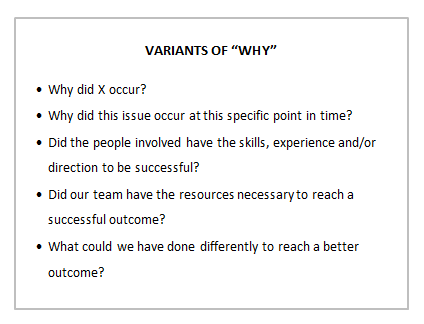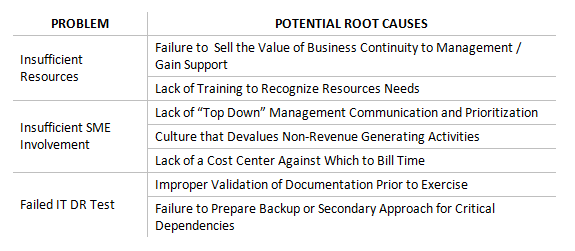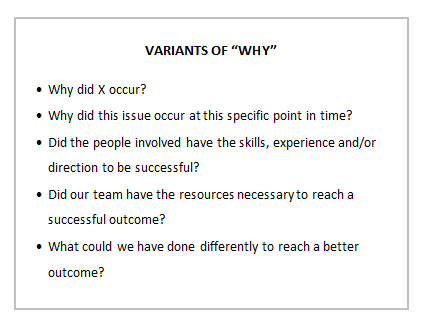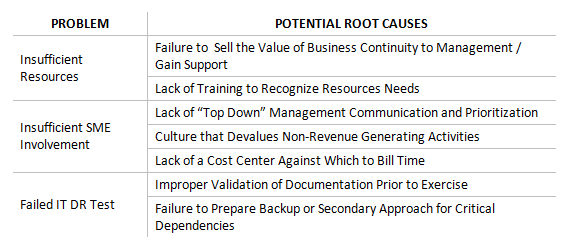..goes unpunished, they say. Nowhere is that more true than with those who respond to disasters- natural or man-made, where death and severe injury is present. These workers are at risk of experiencing stress from what psychologists refer to as a traumatic incident. A traumatic incident is one that may involve exposure to catastrophic events, severely injured children or adults, dead bodies or body parts, or a loss of colleagues. All workers involved in response activities help themselves and their coworkers and reduce the risk of experiencing stress associated with a traumatic incident by utilizing simple methods to recognize, monitor, and maintain health on-site and following such experiences.
A Personal Case Study
As emergency responders, we often feel a need to “be brave”, impervious to the bad things we see, stoic in the face of tragedy. Unfortunately, that is not the case. The very parts of our nature that drive us to respond to disasters- to help those most affected- also prevents us from turning a completely blind eye to what we witness. We may fool ourselves for a while, but sooner or later, it will surface.
Immediately following hurricanes Katrina and Rita, I found myself in New Orleans, serving in the city’s Emergency Operations Center as a Safety Officer. In the ten months I served, four of those months were with the New Orleans Fire Department‘s Urban Search and Rescue team. From March through June, 2006, our mission was to make a final sweep through New Orleans devastated 9th Ward searching for any as yet unfound victims. This entailed going from one ruined home to another, led by teams of cadaver dogs. Climbing over stinking refuse and debris, trying to block out the fact that these had been people’s homes- where children had been raised, homework done, Christmases and birthdays celebrated. And yes, even 6 months after the storms, there were remains to be found. During this mission, twenty six total.
Of all of these, there was one recovery that stands out vividly in my mind. We had been given an address for a couple of residents that had been reported missing by the family- two brothers who had not been heard from since before Katrina had struck. Searching through what remained of the home using the dog teams and literally picking the structure apart with an excavator, the remains of the brothers were finally located. But, the story did not end there. The dog had alerted on something else nearby.
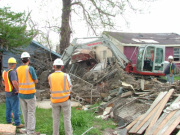
The next morning, it was decided to give it one more try. After a bit more digging and removal of debris around the perimeter, the dog again alerted- this time on a bit of blue canvas half buried in the dried mud. Carefully, the dirt was removed from around the find, uncovering a blue, Tommy the Train child’s knapsack. Underneath that, a small skull and a few other pieces of bone. I never learned her name, only that she had been 6 or 7 years old, and had been wearing the knapsack, ready for her parents to decide whether they were going to evacuate or not. Inside the knapsack were a couple of dolls, and other items that were obviously of great importance to her.
It was over a year after I returned home from my service in New Orleans before I could tell that story to anyone without physically choking up. Of all of the things I had seen or heard during those 10 months- of all of the death and destruction I had witnessed.. that was the one thing that got stuck sideways, as they say. It wasn’t until I sat down with a trusted friend and forced it out, that I was finally able to move past that experience.
I submit this as an example of the kind of stress we all face as emergency or disaster responders. Everyone is familiar with Post Traumatic Stress Disorder (PTSD). TraumaticIncident Stress (TIS), while similar, is not quite the same thing. If not dealt with in a timely manner, however, it can result in PTSD. TIS builds within a person’s psyche incrementally, depending on the severity of the situation and the person’s duties. Those whose duties puts them “in the trenches”, working first hand with victims and the worst of the destruction are the ones most at risk.
Symptoms of Stress
Workers may experience physical, cognitive, emotional, or behavioral symptoms of stress. Some people experience these reactions immediately at the scene, while for others symptoms may occur weeks or months later. The CDC has put together an excellent examination of the issue of TIS- what it is, how to identify it, and how to deal with it. Every person involved in emergency or disaster response should consider it required reading. So, here it is:
Physical symptoms
Workers experiencing any of the following symptoms should seek IMMEDIATE medical attention:
- Chest pain
- Difficulty breathing
- Severe pain
- Symptoms of shock (shallow breathing, rapid or weak pulse, nausea, shivering, pale and moist skin, mental confusion, and dilated pupils)
Workers may also experience the following physical symptoms. If these symptoms occur over time or become severe, workers should seek medical attention. Additional physical symptoms include:
- Fatigue
- Nausea/vomiting
- Dizziness
- Profuse sweating
- Thirst
- Headaches
- Visual difficulties
- Clenching of jaw
- Nonspecific aches and pains
Cognitive symptoms
If these symptoms occur on the scene workers may not be able to stay clearly focused to maintain their own safety or to rescue injured victims. Workers may experience momentary cognitive symptoms; however, if symptoms are chronic or interfere with daily activities, workers should seek medical attention. These symptoms include:
- Confusion
- Disorientation
- Heightened or lowered alertness
- Poor concentration
- Poor problem solving
- Difficulty identifying familiar objects or people
- Memory problems
- Nightmares
Emotional symptoms
Strong emotions are ordinary reactions to a traumatic or extraordinary situation. Workers should seek mental health support from a disaster mental health professional if symptoms or distress continue for several weeks or if they interfere with daily activities. Emotional symptoms include:
- Anxiety
- Guilt
- Denial
- Grief
- Fear
- Irritability
- Loss of emotional control
- Depression
- Sense of failure
- Feeling overwhelmed
- Blaming others or self
- Severe panic (rare)
Behavioral symptoms
As a result of a traumatic incident, workers may notice the following behavioral changes in themselves or coworkers:
- Intense anger
- Withdrawal
- Emotional outburst
- Temporary loss or increase of appetite
- Excessive alcohol consumption
- Inability to rest, pacing
- Change in sexual functioning
Recommendations to Monitor and Maintain Health On-Site
Responders need to take care of their own health to maintain the constant vigilance they need for their own safety. Responders must be able to stay focused on the job in the dynamic, changing emergency environment. Often responders do not recognize the need to take care of themselves and to monitor their own emotional and physical health. This is especially true if recovery efforts stretch into several weeks. The following guidelines contain simple methods for workers and their team leaders to help themselves and their team members. These guidelines should be read while at the site and again after workers return home.
Control the organization and pace of the rescue and recovery efforts
- Pace yourself. Rescue and recovery efforts at the site may continue for days or weeks.
- Watch out for each other. Coworkers may be intently focused on a particular task and may not notice a hazard nearby or behind.
- Be conscious of those around you. Responders who are exhausted, stressed, or even temporarily distracted may place themselves and others at risk.
- Take frequent rest breaks. Rescue and recovery operations take place in extremely dangerous work environments. Mental fatigue, particularly over long shifts, can greatly increase emergency workers’ risk of injury.
Maintain adequate nutrition and rest
- Eat and sleep regularly. Maintain as normal a schedule as possible and adhere to the team schedule and rotation.
- Drink plenty of fluids such as water and juices.
- Try to eat a variety of foods and increase your intake of complex carbohydrates (for example, breads and muffins made with whole grains, granola bars).
- Whenever possible, take breaks away from the work area. Eat and drink in the cleanest area available.
Monitor mental/emotional health
- Recognize and accept what you cannot change—the chain of command, organizational structure, waiting, equipment failures, etc.
- Talk to people when YOU feel like it. You decide when you want to discuss your experience. Talking about an event may be reliving it. Choose your own comfort level.
- If your employer provided you with formal mental health support, use it!
- Give yourself permission to feel rotten: You are in a difficult situation.
- Recurring thoughts, dreams, or flashbacks are normal—do not try to fight them. They will decrease over time.
- Communicate with your loved ones at home as frequently as possible.
Recommendations to Maintain Health Following the Incident
Over time, workers’ impressions and understanding of their experience will change. This process is different for everyone. No matter what the event or an individual’s reaction to it, workers can follow some basic steps to help themselves adjust to the experience:
- Reach out—people really do care.
- Reconnect with family, spiritual, and community supports.
- Consider keeping a journal.
- Do not make any big life decisions.
- Make as many daily decisions as possible to give yourself a feeling of control over your life.
- Spend time with others or alone doing the things you enjoy to refresh and recharge yourself.
- Be aware that you may feel particularly fearful for your family. This is normal and will pass in time.
- Remember that “getting back to normal” takes time. Gradually work back into your routine. Let others carry more weight for a while at home and at work.
- Be aware that recovery is not a straight path but a matter of two steps forward and one back. You will make progress.
- Appreciate a sense of humor in yourself and others. It is okay to laugh again.
- Your family will experience the disaster along with you. You need to support each other. This is a time for patience, understanding, and communication.
- Avoid overuse of drugs or alcohol. You do not need to complicate your situation with a substance abuse problem.
- Get plenty of rest and normal exercise. Eat well-balanced, regular meals.
What is Critical Incident Stress Debriefing?
Critical Incident Stress Debriefing (CISD) is a facilitator-led group process conducted soon after a traumatic event with individuals considered to be under stress from trauma exposure. When structured, the process usually (but not always) consists of seven steps: Introduction; Fact Phase; Thought Phase; Reaction Phase; Symptom Phase; Teaching Phase; and Re-entry Phase. During the group process, participants are encouraged to describe their experience of the incident and its aftermath, followed by a presentation on common stress reactions and stress management. This early intervention process supports recovery by providing group support and linking employees to further counseling and treatment services if they become necessary.
Related articles
- Managing traumatic stress: Tips for recovering from disasters and other traumatic events (apa.org)
- After the Boston Marathon Bombings (drvitelli.typepad.com)
- Critical Incident Stress (osha.gov)
- Managing Stress: A Guide for Emergency and Disaster Response Workers (Free Download) (samhsa.gov)
